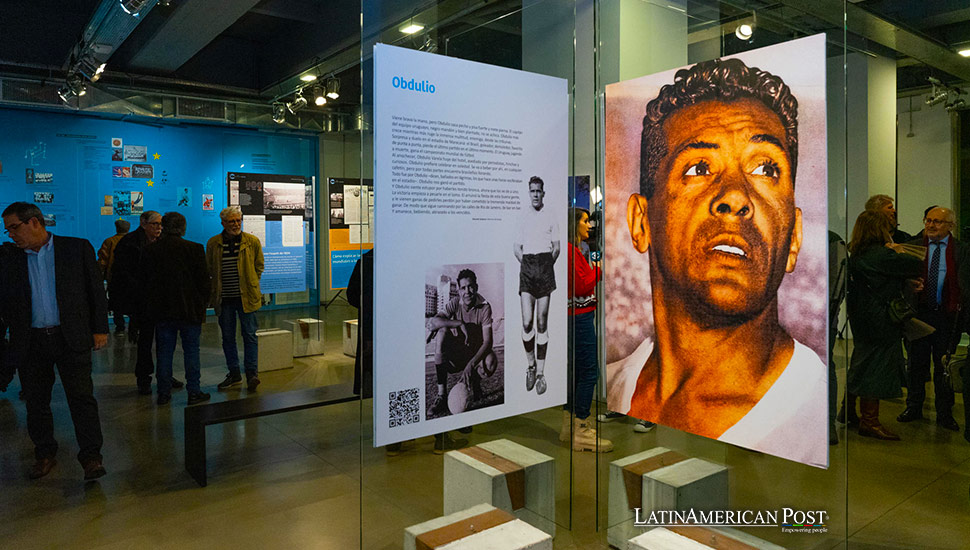Uruguay’s Historic Soccer Triumphs Celebrated in Montevideo Exhibition

A new photographic exhibition in Montevideo chronicles Uruguay’s path to its first world soccer title at the 1924 Paris Olympics, capturing its rich sporting legacy and influence on global soccer history.
In a remarkable homage to Uruguay’s storied soccer history, a new photographic exhibition titled “4 Estrellas” was unveiled in Montevideo. The exhibition, organized by the National Archive of Image and Sound of the Ministry of Education and Culture, showcases the country’s journey to its first world soccer title at the 1924 Paris Olympics and highlights subsequent triumphs that cemented Uruguay’s place in soccer history.
The exhibition features a striking timeline that marks the beginning of Uruguay’s ascent in soccer, starting with the 1924 Paris Olympics. It also covers the 1928 Amsterdam Olympics and the FIFA World Cup victories in 1930 and 1950, illustrating Uruguay’s unparalleled achievements in international soccer. The 1924 and 1928 Olympic victories are particularly noteworthy, as FIFA later recognized these tournaments as world championships, preceding the official World Cup established in 1930.
1924 Paris Olympics: The Birth of a Soccer Legacy
Uruguay’s debut in the 1924 Paris Olympics was nothing short of spectacular. As the national team is affectionately known, the Celeste dominated their opponents with a series of decisive victories. They defeated Yugoslavia 7-0, the United States 3-0, France 5-1, and the Netherlands 2-1, securing their place in the final. On June 9, 1924, in front of 40,000 spectators at the Colombes Stadium, Uruguay clinched their first world title with a 3-0 victory over Switzerland.
“Europe had no idea how Uruguay played, and there was a prejudice against everything from South America. After the victory, the players ran around the field to greet the crowd, which marked the birth of the ‘Olympic lap,'” said Sebastián Bauzá, the National Secretary of Sports, during a commemorative speech. The South American Football Confederation (CONMEBOL) later declared June 9 as “South American Soccer Day” in honor of this historic win.
The exhibition vividly portrays Uruguay’s soccer history, featuring photographs, texts, paintings, and videos that tell the story of the nation’s soccer triumphs. Armando Sartorotti, the curator, noted that while he learned little about soccer during the exhibition assembly, he gained profound insights into human values such as sacrifice, resilience, pride, and humility.
“These players from 1924 traveled in third class on the ship Desirade, just like our ancestors who came to this country, and we see them in one of the photos, laughing and training on the ship’s deck,” Sartorotti remarked. He also highlighted the efforts of the Uruguayan team, who played friendly matches in Spain to raise funds for their trip to Paris.
The Road to Amsterdam and Beyond
Following their success in Paris, Uruguay continued to dominate international soccer. At the 1928 Amsterdam Olympics, the Celeste once again showcased their prowess, securing another gold medal. These victories set the stage for the inaugural FIFA World Cup in Montevideo in 1930. Uruguay’s national team triumphed on home soil, defeating Argentina 4-2 in a thrilling final at the Estadio Centenario, further solidifying their status as a soccer powerhouse.
Uruguay’s fourth star came in 1950 during the World Cup in Brazil, where they pulled off one of the greatest upsets in soccer history. The “Maracanazo,” as famously known, saw Uruguay defeat the heavily favored Brazilian team 2-1 in the final match at the Maracanã Stadium in Rio de Janeiro, in front of nearly 200,000 spectators. This victory remains a defining moment in soccer history and a source of immense pride for Uruguay.
The Legacy of Uruguayan Soccer
Uruguay’s soccer legacy is deeply intertwined with the nation’s identity. The resilience and tenacity displayed by the early teams continue to inspire generations of Uruguayan players and fans. “This exhibition shows what it means to be Uruguayan. Through great sacrifice, we have achieved incredible titles that are part of the national identity,” emphasized Bauzá.
The exhibition also features personal anecdotes and reflections from legendary players like Héctor Scarone, who was part of the 1924 team. “The public wanted to see us up close. They threw flowers at us; it was unforgettable,” Scarone once said, as recounted in one of the exhibition’s texts.
Uruguay’s early successes in international soccer helped establish South America as a dominant force. These achievements paved the way for other Latin American nations, including Brazil and Argentina, to rise to prominence on the global stage. The region’s passionate fan base and a rich tradition of developing talented players have made Latin America a soccer powerhouse.
Soccer in Latin America is more than just a sport; it is a cultural phenomenon that unites communities and fuels national pride. Teams like Uruguay’s Celeste’s victories symbolize resilience and hope, reflecting the region’s broader struggles and triumphs.
Celebrating a Rich Legacy
The “4 Estrellas” exhibition in Montevideo is a powerful tribute to Uruguay’s illustrious soccer history. It celebrates the country’s historic victories and honors the values and spirit that have defined Uruguayan soccer for nearly a century. As visitors explore the photographs, artifacts, and stories, they gain a deeper understanding of the sacrifices and achievements that have shaped the nation’s sporting legacy.
Uruguay’s journey from the 1924 Paris Olympics to its continued influence in global soccer is a testament to the enduring power of sport to inspire and unite. The exhibition serves as a reminder of the rich history and bright future of Uruguayan soccer, encouraging new generations to carry forward the legacy of the Celeste.
Also read: Brazilian Football Faces Controversy as Palmeiras Seeks Botafogo Owner Expulsion
Through this celebration of past glories, Uruguay reaffirms its place in the pantheon of soccer greats, highlighting the nation’s ongoing contribution to the world’s most beloved sport.





